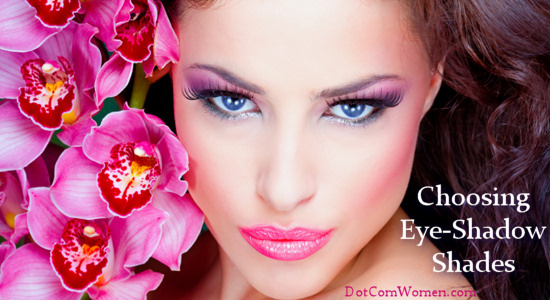Choosing Eye Shadow Shades
Eye shadow is a great way to bring out your eye color and help you look polished and put together. That is, when it’s chosen and applied correctly! Here are some tips to help you choose the ideal eye shadow shades for your particular eye color.

The two schools of thought when it comes to choosing your eye shadow color are complementary and contrasting colors. For example, Liz Taylor always wore purple eye shadow to bring out her gorgeous violet eyes. This is an example of complementary colors. Contrasting colors would be the opposite of your eye color and can also work well to make the color of your eyes the main focus. Experiment and find out which method you prefer for your eye makeup. It helps to experiment beforehand in case of parties, but is a MUST in case of wedding makeup.
For Blue Eyes
Try warm brown shades like toffee, caramel and gold to bring out blue eyes. One great idea is to use neutral shadows in warm shades, then line with navy blue liner or try a dark blue mascara to make eye color pop. Pink or Fuchsia, as shown above, can be applied when going in for a smoky eye effect.
For Green Eyes
Green eyes look great in shades of purple, from light to dark. Copper, burgundy, fuchsia and rust shades also look stunning on green-eyed girls. Or, try a deep emerald shade for a complementary color.
For Brown Eyes
Brown eyes look gorgeous in many shades, including blue and purple. Go neutral with a shimmering champagne shadow, or try a medium rose shadow for a feminine flush.
For All Eye Colors
You can’t go wrong with neutrals! Shades like beige, toffee, fawn and chocolate look fantastic with all eye colors. If you’re in the mood for a little color but not too much, use light beige wash of color over entire lid then finish with a colored liner in the shade of your choice.
If you want the perfect colors for your eye color in one convenient kit, try one of the sets designed for particular eye colors like the Intense I-quads offered by Almay or Pop Beauty’s eyeshadow cakes.
Don’t be afraid to experiment with your eye shadow color. However, a good rule of thumb is lightest color on the browbone, darkest in the crease, medium shade on the lids. However, neutrals and pastels can be used on both the lid and browbone areas. Powder shadow offers the easiest application, while cream shadows give a glowy look that’s easily blendable. Shadows can be applied wet or dry, for a dramatic look or one that’s more natural. The best thing about shadow is its versatility!
